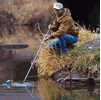
Wetlands and riparian areas play important roles in filtering out pollutants from runoff, preventing soil erosion, providing flow control, enhancing surface and groundwater storage, providing aquatic and semiaquatic habitat, supporting biological diversity, and providing areas for recreation.
Wetlands are areas that are periodically or permanently inundated or saturated with water and support a prevalence of vegetation typically adapted for life in saturated soils. Wetlands provide many important functions and values, including:
Riparian areas are ecosystems bordering a river or stream, where soil moisture is more or less permanently available. Riparian areas are highly productive transitional areas between streams and terrestrial uplands, and support a diverse community of plants and animals. Riparian zones maintain the health and productivity of the stream environment. They reduce the transport of sediment and nitrates from the terrestrial to the aquatic environment, sustain microclimates, and provide large woody debris (which is a source of food and habitat structure).
Changes in hydrology, geochemistry, substrate, or species composition can impair wetland and riparian areas and reduce their ability to filter out pollutants in runoff, which can result in poor water quality in the receiving waters.
Engineered vegetated treatment systems (such as constructed wetlands, vegetated filter strips, buffers, and swales) treat NPS pollution by increasing the interaction time between runoff, soil, and plants. This increases the ability of pollutants in runoff (nutrients, some metals, and some organic molecules) to be attenuated, transformed, absorbed, and volatilized by various processes. Vegetated treatment systems can be placed in upland areas to protect wetlands and other aquatic resources from NPS pollution.
Descriptions of this land use category and its Management Measures are adapted from California’s NPS Encyclopedia. More Info

Protect and conserve functional wetlands and riparian areas, which provide services such as improvement of water quality; surface and groundwater storage; flood control; storm surge attenuation; wildlife and aquatic habitat; and opportunities for recreation and cultural activities. More Info
Promote the restoration of degraded or destroyed wetlands in areas where they can reduce NPS pollution. Restoration of self-sustaining functions in damaged wetlands and riparian areas includes reestablishing vegetation, hydrology, and structural characteristics. More Info


Promote the strategic use of engineered vegetated treatment systems (such as constructed wetlands, vegetated filter strips, buffers, and swales). These systems serve a polluted runoff abatement function, through filtration, deposition, infiltration, absorption, adsorption, decomposition, and volatilization of pollutants. More Info
Implement educational programs to improve understanding of watersheds and increase the use of applicable Management Measures and practices for wetlands and riparian areas. Promote projects that retain or reestablish natural hydrologic functions. More Info
